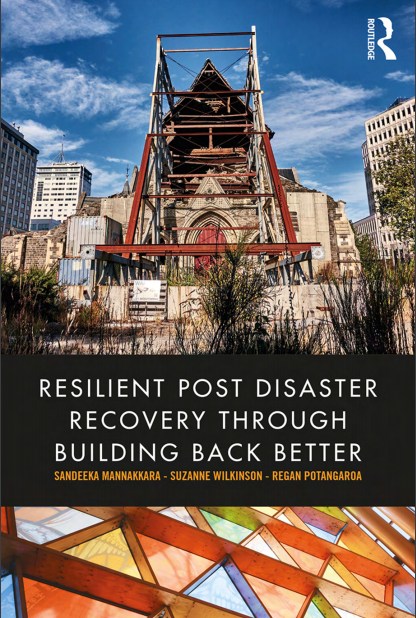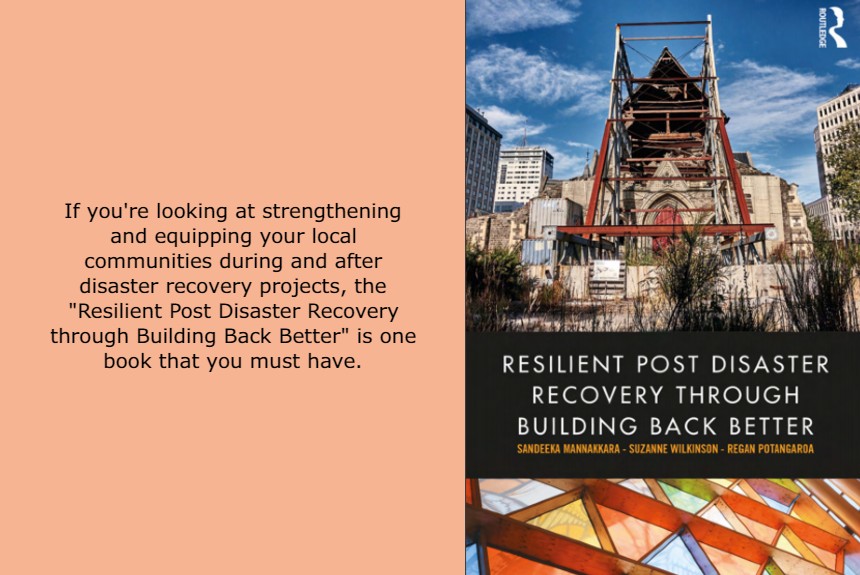This post features the book Resilient Post Disaster Recovery through Building Back Better, 1st Edition, which Sandeeka Mannakkara co-authored with Suzanne Wilkinson and Regan Potangaroa.
The book explores the concept and principles behind Building Back Better (BBB), a famous slogan for post-recovery efforts after significant disasters.
The term was first popularised following the 2004 Indian Ocean Tsunami and has since been associated with many events, such as the 2009 Samoan Tsunami, the 2010 Haiti Earthquake, and the 2011 Great East Japan Earthquake.
In a nutshell, BBB is an ‘innovative holistic approach to rebuilding a community following a disaster event to develop resilience’.
The United Nations Sendai Framework for Disaster Risk Reduction has identified “Building Back Better” as one of the four priorities of action for global disaster risk reduction in the next 15 years.
There has been confusion and mismatch about the BBB concept, making it challenging to implement and sometimes unsuccessful. This book attempts to shed clarity and provide recovery stakeholders such as governments, NGOs, the private sector, academia and students with the tools to understand and implement the concept for better results.
The book presents Building Back Better’s background, development, and definitions.
The authors developed the internationally recognised BBB framework and its components based on more than ten years of research explored and explained in the book.
The book also includes findings from international research and case studies in countries such as the US, Gaza, China, Australia, UK, Fiji, the Cook Islands, Sri Lanka and New Zealand, which provides readers and users practical recommendations for planning and implementing recovery projects.
The book discusses such subjects as:
- construction and materials
- building project management and techniques
- Green constructions
- cities and the developing world
- engineering and technology
- georisks and hazards
- structural engineering
- geography: hazards and disasters
- finance, economics, business, and industry
- project management
The book has 11 chapters
- Chapter 1 – Post-disaster recovery and the need to Build Back Better
- Chapter 2 – Build Back Better Theory
- Chapter 3 – Structural resilience
- Chapter 4 – Multi-Hazard-based Land-Use Planning
- Chapter 5 – Early Warning and Disaster Risk Reduction Education
- Chapter 6 – Psychological and Social Recovery
- Chapter 7 – Economic Recovery
- Chapter 8 – Institutional Mechanism
- Chapter 9 – Legislation and Regulation
- Chapter 10 – Monitoring and Evaluation
- Chapter 11 – Building Back Better: from theory to practice.
Users will find “Resilient Post Disaster Recovery through Building Back Better” valuable and practical in planning and implementing disaster recovery projects.
Disaster-prone countries, especially Asia and Pacific countries facing climate change risks, will find this book helpful in their post-disaster, climate adaptation, mitigation planning, and strategies.
This handbook is excellent for governments, non-government, and private industries in post-disaster recovery projects to strengthen and equip local communities during and after disaster recovery projects.
Suppose you’re looking at strengthening and equipping your local communities during and after disaster recovery projects. In that case, “Resilient Post Disaster Recovery through Building Back Better” is one book you must have.
This book, “Resilient Post Disaster Recovery through Building Back Better”, is available now, and you can buy this book by CLICKING on the image below:




Leave a Reply